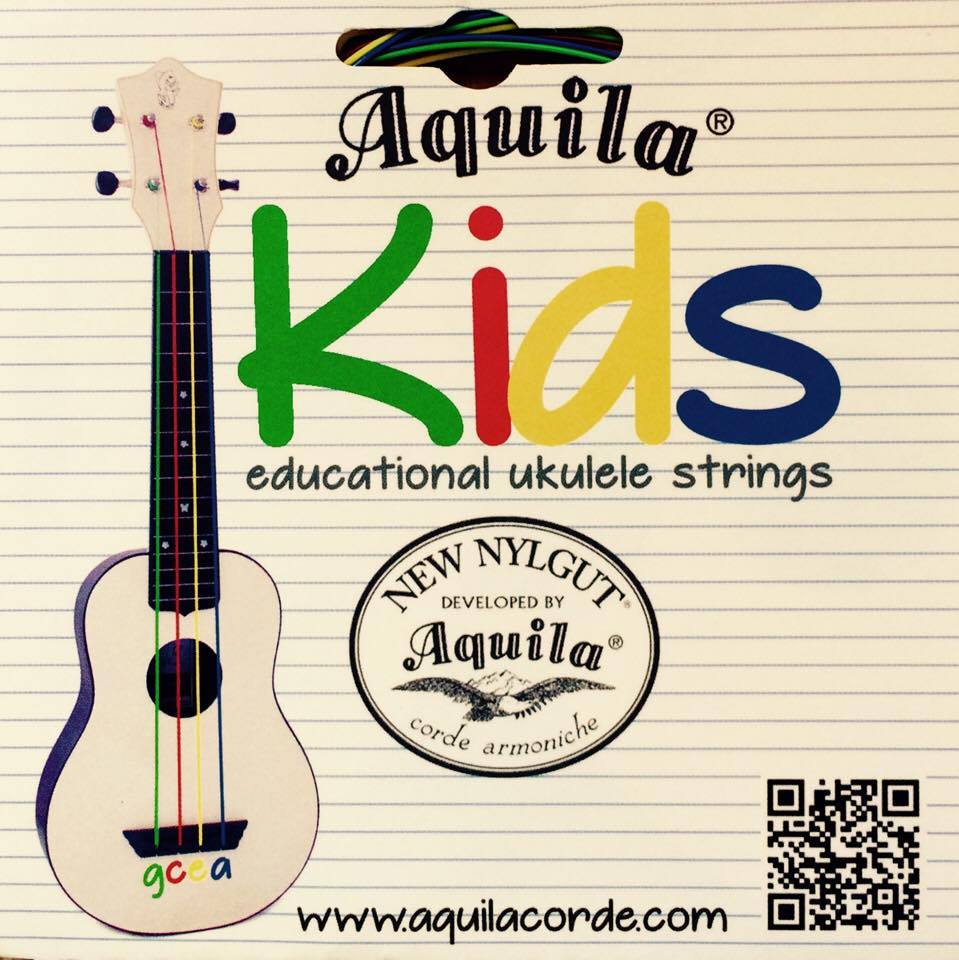| A post on Facebook made me realize that I hadn't gotten around yet to reviewing and showing some fun things you can do with these new Aquila Kids Strings! If you've read my "Tips and Tricks" portion of the website, you know that I have been a proponent of using fishing line for strings in the event that you are on a limited budget. Presuming you can't find local fishermen who are willing to give you some extra fishing line (of which they probably have tons), you can string your ukes for somewhere in the realm of $1.50-2.00 per instrument, and I personally prefer the sound of them to a lot of strings. |
And then came the Aquila Kids Strings, which honestly seemed like a gimmick to me at first. In fact, I have a visceral reaction to anything that makes the ukulele seem more "toy" than a legitimate instrument, so I ignored them at first. And then I got my ukulele snobbery under control (yes, it exists, and I may just have to battle it in myself from time to time...) and thought about the possibilities.
How many of us teaching ukulele and/or guitar have had to continually do the "First String...No...that's the fourth string..." thing in class? This certainly makes it easier...especially when incorporating left-handed ukuleles into your curriculum. When I realized that you could color notes in Sibelius, I was sold, and contacted Aquila to order a set.
I was completely floored when I realized that the cost of them (when sold directly to schools) came out to be around $2.50 a set...barely more than using fishing line, and a LOT more useful! I re-strung all of my ukuleles at the end of last year, and immediately started seeing a difference in the students' learning. When I purchased 30 new ukuleles over the summer, I re-strung them as soon as they arrived.
I've especially found them useful with my more advanced students that have moved out of first position. The pitch C5 (C above middle C) can be played in 4 different places on the ukulele. When I'm writing out the sheet music for students in fifth position, etc, I indicate the position in the traditional way, but I also color the note for the string it's on...sure helps them find it quicker when reading! See the arrangement of "Infant Holy, Infant Lowly" below as an example, and feel free to use it! The second page takes advantage of re-entrant tuning in a style called campanella. I've included tablature on that line to illustrate how the string colors are showing the location of each note.
Likewise, I've re-done my chord posters in my room to reflect the string colors. Again, this makes it so I don't have to have separate chord diagrams for lefties...very handy!
Can you do this simply by putting beads or stickers to indicate which string is which? Sure...absolutely. But when the cost of the strings is so low, and the benefits are high, I see no reason not to go with them!
How many of us teaching ukulele and/or guitar have had to continually do the "First String...No...that's the fourth string..." thing in class? This certainly makes it easier...especially when incorporating left-handed ukuleles into your curriculum. When I realized that you could color notes in Sibelius, I was sold, and contacted Aquila to order a set.
I was completely floored when I realized that the cost of them (when sold directly to schools) came out to be around $2.50 a set...barely more than using fishing line, and a LOT more useful! I re-strung all of my ukuleles at the end of last year, and immediately started seeing a difference in the students' learning. When I purchased 30 new ukuleles over the summer, I re-strung them as soon as they arrived.
I've especially found them useful with my more advanced students that have moved out of first position. The pitch C5 (C above middle C) can be played in 4 different places on the ukulele. When I'm writing out the sheet music for students in fifth position, etc, I indicate the position in the traditional way, but I also color the note for the string it's on...sure helps them find it quicker when reading! See the arrangement of "Infant Holy, Infant Lowly" below as an example, and feel free to use it! The second page takes advantage of re-entrant tuning in a style called campanella. I've included tablature on that line to illustrate how the string colors are showing the location of each note.
Likewise, I've re-done my chord posters in my room to reflect the string colors. Again, this makes it so I don't have to have separate chord diagrams for lefties...very handy!
Can you do this simply by putting beads or stickers to indicate which string is which? Sure...absolutely. But when the cost of the strings is so low, and the benefits are high, I see no reason not to go with them!



 RSS Feed
RSS Feed
